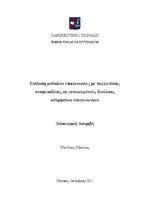Επίδοση μεθόδων επικοινωνίας με πολλαπλούς αναμεταδότες σε γενικευμένους διαύλους ασύρματων επικοινωνιών

Προβολή/
Θεματική επικεφαλίδα
Wireless communication systems ; Radio relay systems ; Digital communications -- Reliability -- Mathematics ; Error-correcting codes (Information theory) ; Stochastic analysisΠερίληψη
Στην παρούσα διδακτορική διατριβή, αποδεικνύονται αναλυτικές εκφράσεις για διάφορα κριτήρια επίδοσης των συστημάτων πολλαπλών αναμεταδοτών σε περιβάλλοντα διάδοσης που χαρακτηρίζονται από σύνθετα μοντέλα διάλειψης. Στο Κεφάλαιο 1 γίνεται μία επισκόπηση των μοντέλων διάλειψης μικρής και μεγάλης κλίμακας για το ασύρματο κανάλι. Στο Κεφάλαιο 2 δίνεται μία επισκόπηση των κυριότερων συστημάτων αναμεταδοτών που έχουν προταθεί για τα ασύρματα συστήματα με βάση την ενίσχυση που χρησιμοποιείται και τον τρόπο συνδεσμολογίας αλλά και επιλογής των αναμεταδοτών. Στο Κεφάλαιο 3, αποδεικνύονται νέες και εύκολα υπολογίσιμες μαθηματικές εκφράσεις για την πιθανότητα σφάλματος σε συστήματα που υποστηρίζουν πολλαπλούς αναμεταδότες σε παράλληλη συνδεσμολογία και απευθείας διαδρομή με maximal ratio combining στο δέκτη. Στο Κεφάλαιο 4, παρουσιάζονται νέες μαθηματικές σχέσεις για την αξιολόγηση της επίδοσης ενός δικτύου με αναμετάδοση δύο ζεύξεων και επιλογή του καλύτερου αναμεταδότη σε περιβάλλον με ανεξάρτητα κανάλια διάλειψης. Στο Κεφάλαιο 5, αποδεικνύονται νέες μαθηματικές σχέσεις μέτρων επίδοσης για συστήματα πολλαπλών αναμεταδοτών (multi-hop relays) που λειτουργούν σε ένα σύνθετο περιβάλλον διαλείψεων, το οποίο μοντελοποιείται με τη Γενικευμένη-Κ κατανομή. Χρησιμοποιώντας την προσέγγιση του συνολικού ΣΘΛ για το σύστημα πολλαπλών αναμεταδοτών το οποίο δίνεται από το ελάχιστο ΣΘΛ όλων των ζεύξεων, παρέχεται ένας εύκολος τρόπος υπολογισμού για την πιθανότητα διακοπής και της μέσης πιθανότητας σφάλματος συμβόλου και bit για διάφορες ψηφιακές διαμορφώσεις. Στο Κεφάλαιο 6, αποδεικνύονται κατώτερα όρια κλειστής μορφής για την επίδοση των συστήματα πολλαπλών αναμεταδοτών που λειτουργούν σε ένα Nakagami-m κανάλι διαλείψεων. Το συνολικό ΣΘΛ στον προορισμό προσεγγίζεται από το γεωμετρικό μέσο όρο όλων των ζεύξεων. Με αυτή την προσέγγιση, βρίσκονται μαθηματικές εκφράσεις κλειστής μορφής για τις στατιστικές του συνολικού ΣΘΛ. Αυτές, με τη σειρά τους, χρησιμοποιούνται για να υπολογιστεί η πιθανότητα διακοπής, η μέση πιθανότητα σφάλματος συμβόλου και ένα ανώτερο όριο για τη μέση εργοδική χωρητικότητα του συστήματος πολλαπλών αναμεταδοτών. Τέλος, στο Κεφάλαιο 7 εξετάζεται η επίδραση ομοδιαυλικής παρεμβολής στην πιθανότητα διακοπής ενός ασύρματου συστήματος με ένα ΕΠ αναμεταδότη σε περιβάλλον με Rayleigh διάλλειψη.


